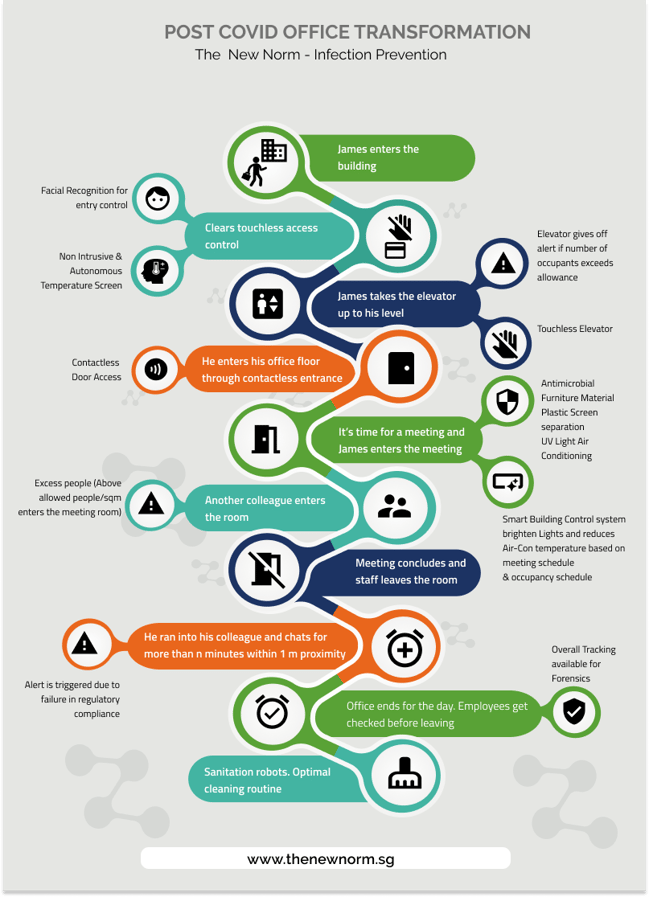A vision of how smart technology can change the way buildings are designed and maintained to safeguard occupant health and well-being
COVID-19 has dramatically transformed how society thinks and interacts. Extended lockdowns around the world have resulted in working, studying, and shopping from home becoming the new norm. Ultimately, pandemics and infectious diseases are cyclical and will continue to strike hardest in the heart of densely packed cities.
Hence, the smart cities and buildings of tomorrow must evolve rapidly and step up as a key contributor in pandemic management, public health, and safety. Here’s a diagram of what a typical day in a COVID-free smart building could look like.
 Infographic by Vinod Bijlani, courtesy of www.thenewnorm.sg
Infographic by Vinod Bijlani, courtesy of www.thenewnorm.sg
James enters the smart building clutching his laptop case and mobile phone. He needs to clear the touchless entry and temperature screening before he is allowed to enter the building.
Touchless entry and fever and mask detection technology are the key safety measures at all entry points. Combining that with thermal imaging with video analytics and AI techniques will provide a robust system to identify individuals, their body temperature, and whether they are wearing masks.
To enhance fever detection, facial and skin temperature data is sent to AI models which track temperature information. Any anomaly with historical data is flagged. This system will eventually be integrated with public health care systems (such as contact tracing) to accelerate tracking speed, locate exposed individuals, and quickly contain the spread of infection.
James then enters the elevator to get to his office. Smart panels for elevators and doors is another critical technology which helps prevent cross infection. Voice-activated technology or touch-less buttons are integrated with the management systems to control common facilities such as elevators, washroom doors, and so on. Alternatively, buttons could be activated by hand proximity and motion detection—without physical contact.
James arrives at the floor where his office desk is located. Most of the furniture is made from antimicrobial material that is resistant to microbes. A clear plastic screen separates him from his colleagues and the air conditioning system uses UV light to kill harmful microorganisms.
To ensure that James observes appropriate social distancing from his colleagues, data from video-based solutions is fused with information from occupancy sensors to detect social distancing violations and raise alerts to the administration teams.
As work is now carried out in split teams, James’s team works on a different schedule from his colleagues in another team. This means lower office occupancy. Data on occupancy is correlated with lighting and HVAC data to help avoid unnecessary cooling/heating of unoccupied areas. This reduces not only power consumption but also overall maintenance.
AI models can analyze current and historical occupancy information to plan optimal cleaning routines. Robotic applications such as sanitation robots can be fitted with arms that mimic human movement, and can be deployed to hard-to-reach or hazardous areas. By using electrostatic spray nozzles, they can disperse disinfectants more widely and evenly on critical surfaces. Additionally, they can be equipped with ultraviolet (UV-C) light powerful enough to irradiate and destroy microbes such as bacteria and viruses.
The above measures are just the tip of the iceberg. Developments in smart building technology are accelerating in this new direction, and there are many innovations to come. In the aftermath of COVID-19, I foresee comprehensive sets of health and safety regulations coming into action from employment agencies and authorities. In all likelihood, there will be regulatory inspections and audits on both individual and organizational compliance.
Smart building systems as described above will greatly help businesses and organizations to automate increasingly complex facilities management and monitoring processes, practice effective crowd control, and meet regulations.
Interested in reading more articles like this? Subscribe to ISA Interchange and receive weekly emails with links to our latest interviews, news, thought leadership, tips, and more from the automation industry.




